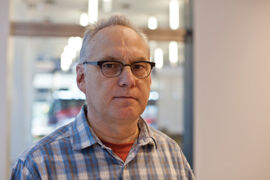
Two Decades of Supporting Student Voices

by Holly Bresnahan (MA 2014)
Michael x. Ryan was the Faculty Advisor for SUGs from 1994 to 2013. Over that time he helped hundreds of SAIC students find a forum for their voices and an outlet for their innovative, challenging work. On the occasion of the 20th anniversary of SUGs, we spoke with him about the SUGs legacy within the SAIC community and beyond.
SUGs provides the first professional exhibition experience for many artists at SAIC. It also gives directors and volunteers hands-on experience working in a highly visible, public exhibition space. What do artists and directors–as students–gain from their involvement with SUGs?
From day one, SUGs has been about student voice, about students organizing themselves to get something done. When people go to school, it’s their goal to build a set of skills that will enable them to go out into the world and model their vision. You can achieve that in the studio, but when you get into an exhibition space, ideas really become social, they become physical. In that way, SUGs provides a great symbol for life after school.
SUGs has acquired a long list of influential alumni—both past exhibitors and directors. How have they contributed to the art community in Chicago and beyond?
SUGs is part of the fabric of the SAIC community, but it is also a large part of the Chicago art community. A few years ago, there was an exhibition at the Hyde Park Art Center called Artists Run Chicago. I met with the two curators about the project, and they pointed out that a large percentage of people involved in the exhibition had ties to SUGs. That's been pretty common. I often have people come up to me who make connections between SUGs alumni.
Since its founding, SUGs has operated under the motto "Student Run/Student Work." How is this reflected in the way the gallery is run and operates?
For last 10 years, SUGs has operated with five directors: an administration director, two installation directors, plus one to two communication directors. SUGs also has a network of gallery attendants that really feel like a part of the team. This structure still exists and I think it's a real strong one. Because I'm a faculty member, I see everything we do here as educational. I see the gallery, as well as the back office and the back room, as a classroom where students are always solving problems.
SUGs has undergone significant changes in the past few years, with the addition of the LeRoy Neiman Center Gallery and the founding of SUGs Projects. Can you reflect on the evolution of SUGs over the years?
I take great pride in the fact SUGs is now on the ground floor of a campus center a block away from the museum. I'm not aware of any exhibition space connected to a school that’s as visible to a public audience. It shows that SAIC has great respect for and confidence in our students and in the structure of the gallery.
SUGs isn’t just about students believing in students, but faculty and administration believing in students. I'm getting goosebumps right now even saying that because that's not just talk; there's a lot that goes into this and there's a lot of support.
Everything at SUGs always goes back to student voice, student dialogue, and sharing that with the community. From day one, the SUGs program has always been about community and respecting everyone. From the minute you walk in the door to the minute you walk out, you are treated with great respect. Nothing that's done here can happen without everyone. I think that stays with students when they go off into the world and do what they want to do.
